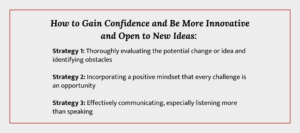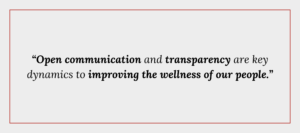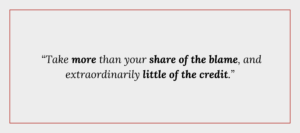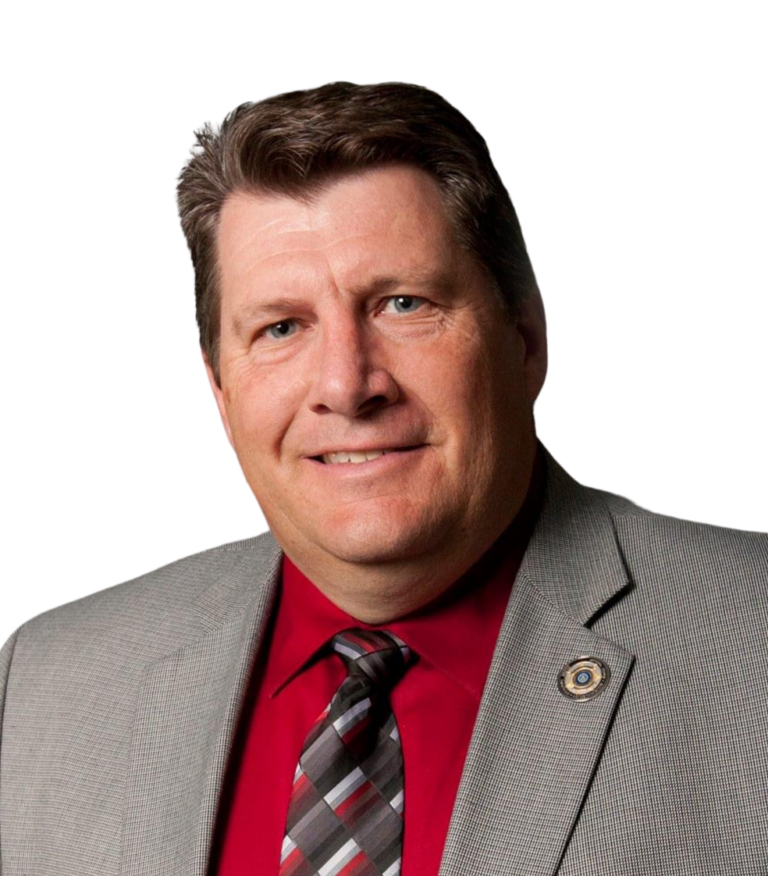
Our Time to ‘Be About It’: How Successful Leaders Lead Implementation
Speaking from Humble Experience
If you are anything like me, you have spent countless hours improving your ability to lead people and teams. In public safety, we understand the positive impact great leadership can have on our challenging work environment and especially upon those we serve. A great deal of effort is poured into providing leadership training, cultural assessments, employee surveys, and strategic planning. This has proven even more true as our industry has faced unprecedented challenges associated with recruitment, retention, and public scrutiny.
We have become well-versed in leadership concepts such as servant and transformational leadership, emotional intelligence, empowerment, delegation, transparency, wellness, mentoring, and strategic planning. I would go as far as to say that public safety leadership has put more effort into learning these concepts than the average private sector organization. This is due in part to the negativity associated with our responsibilities and more recently, the additional burdens placed upon our employees because of the challenges associated with staffing. As a profession, we cannot safely function with poor leadership.
Making Sure the Rubber Meets the Road
As I previously mentioned, equally concentrated efforts have been made by departments in conducting cultural assessments, staff surveys, and building strategic plans. I have been fortunate to assist many organizations in these areas through focus groups, interviews, and work sessions, and it never ceases to amaze me how informed and knowledgeable the staff are about our work and responsibilities. Typically, they are engaging and want to be part of the solution and not part of the problem. They make great suggestions, take ownership of challenges, and are willing to do their part to become better if empowered to do so. Unfortunately, one thing that is often lacking from all these significant efforts around leadership, organizational culture, and strategic operations is the ability and the fortitude to implement what we learn. It is getting things done. It is walking the talk. It is following through on what you say. Or, as they say today, “less ‘talk about it’ and more ‘Be About It!’”
Implementation is the “Be About It,” and it’s the most difficult part of the process. This is where it takes genuine courage to be vulnerable and transparent – two traits that are often looked upon in our industry as weaknesses or flaws. However, when we fail to apply learned leadership principles, consider suggested ideas, pilot alternative proposals, or take proper action supported by survey data, we fail ourselves, those we lead, and all the efforts put into gaining our employees’ perspectives.
“Be About It” – For Yourself and For Others
Another challenge associated with “Be About It” is our ability to empower those around us, especially those closest to the work or tasks we are looking to change or improve. Due to the incredible amount of liability and scrutiny associated with our work, we sometimes over-supervise situations and projects rather than lead them. It can look and feel like we maintain a stranglehold on every decision that needs to be made. We should be doing more to empower others and grow our teams and organizations through shared experiences and mentoring through trials, failures, and successes. Just like we read about in those leadership books and learned in training seminars, right?
One of the incredible gifts of our profession is that we are never alone. We have each other and we can turn to our professional family to provide us with ideas and potential solutions to our challenges. We often use the phrase, “No need to reinvent the wheel,” and that should also be our approach to improving implementation. I have personally struggled through various stages of “Be About It,” and gained some perspective and knowledge that may assist you along the way.
Spoiler Alert: There is no secret formula. You use the leadership concepts we have all been learning throughout our careers; applying them to implementation steps and ideas that have worked to not only lead more effectively, but also to get things done and improve the effectiveness of our operations.

Finding the Courage to “Be About It”: Three Strategies to Try
As mentioned, to “Be About It” requires courage, and many of us have more courage than we think. We just have not stretched far enough from our comfort zone to find out. Renowned leadership author John C. Maxwell writes, “One of our biggest misconceptions is that courage equals a lack of fear. In actuality, the opposite is true.” You don’t need to be fearless, nor should you be – if you do not have any fear, you are likely to make decisions that you will regret.
Don’t like describing yourself as being afraid? Then describe it as being cautious, but to “Be About It,” you will need to be willing to take risks; so how do we gain the confidence to be more innovative and open to new ideas? Three strategies have improved my ability in these areas:

Let’s take a closer look at each of the strategies above to see how they can help:
Strategy 1: Start with Identifying Your Obstacles
One of the best ways I have learned to overcome some of those fears is to become more strategic, inquisitive, and calculated in my approach to risk. I evaluate all potential outcomes, collect data (facts), identify negative consequences and potential ways to mitigate things identified as obstacles. When asking for insight, it is important to ask not only your leadership team but also those who would be affected by the change. Do not let them simply say, “it will not work.” Ask them to tell you why. Ask them for ways they think it could work, and if they identify challenges, ask them for their thoughts on how those consequences or obstacles can be overcome.

Strategy 2: Never Underestimate the Power of Positivity
As part of this evaluation and engagement with employees, it’s important to express your belief that the challenges we face present us with opportunities to gain experience and improve. As public safety professionals, we can be pessimistic (and certainly sarcastic), so expect some pushback. “Be About It” leaders recognize the power of using emotional intelligence and remember what it was like to be in the positions of those they now serve. The strong leaders you worked with in the past were usually positive, encouraging, and hopeful. Positivity is not a weakness, but a strength, and the absolute best of us find ways to bring light to what can be a tough and sometimes dark work environment.
Strategy 3: ‘Communicate, Communicate, Communicate… Starting with Your Ears!
Another important leadership trait is communication, especially the ability to listen. Do not listen to interrupt or only to those who always agree with you but actively listen to those with dissenting points of view from your own. “Be About It” leaders understand that we are responsible for leading everyone – not just the people who make us feel comfortable or share our same hobbies and interests, but those who think differently and at times can be a bit cantankerous.
Consider using stay interviews, rather than exit interviews. Meet with employees and listen to their thoughts and concerns while they are still planning to stay or have not committed to leaving the organization. Provide them with insight into things you would like to implement and get their perspective. Proactively involve them in the process by assigning them to teams expected to implement or pilot new projects.
The key is not being a know-it-all or treating them as if they do not understand. Include them in producing solutions and watch them become your strongest advocates for change. People support what they help create. Unfortunately, the fear of having someone suggest a better way sometimes prevents us from utilizing this incredible leadership concept and gaining significant support for implementation.

The “Be About It” approach also requires us to use learned leadership concepts such as transparency and follow-up. When asking for our employees’ input, we need to provide them with as much information as possible, so they can weigh the challenges effectively. There will be some things that cannot and should not be discussed, but sharing as much as possible will be felt by those listening and will be added to their knowledge base and trust in leadership. Take time to follow up with those you have met to provide an update or further discuss potential solutions. These interactions do not all have to be in person or long. In fact, an email covering the topic can provide the conduit “Be About It” leaders use to improve communication with their employees. Open communication and transparency are key dynamics to improving the wellness of our people.
Now that you’re equipped with actionable strategies to bolster your confidence and improve your leadership approach to taking risk, it’s time to put them to work; beginning with identifying some of the biggest obstacles you’ll face when attempting implementation.
Priorities and Action Teams: Common Challenges
Without question, the planning and meeting process to accomplish actual implementation can be the most cumbersome. This is where projects often stall if leaders fail to prioritize, engage, empower, and communicate. Most of us are great at pulling together small teams to begin the implementation process but fail to prioritize this work in cooperation with our operational challenges. Simply put, we let the day-to-day get in the way. When that happens, these groups simply lose traction, and people assigned to the project begin to lose interest since their priority is not balanced with operations by the leadership.
Balancing Priority Projects and Operations
“Be About It” leaders recognize the importance of both and prioritize them accordingly. Our work can quickly require a change to focus more on operational challenges, and this should always be taken into consideration. However, we must plan for such interruptions ahead of time and schedule specific intervals for report-backs and milestone updates. Timelines must be established early on and continuously monitored to ensure the projects are completed as close to the deadlines as possible.
When other responsibilities interfere and require a reschedule, the reschedule should be timely and given the high priority it deserves. Remember: these implementation projects came about because a need was identified using assessments and data. If we do not address the challenges as they have been presented, then we are simply ignoring evidence and factors that are contributing to our organizational challenges.
Death by “Committee”
Another effective, yet subtle change is to refrain from calling your implementation team a “committee.” Public safety has been consumed by committees for far too long… just hearing the word can leave most professionals running for the door. They also tend to conjure up ineffective discussion groups and efforts that simply fail to take any action.
As a “Be About It” leader, consider referring to them as “advisory groups,” “task forces,” or “action teams.” Choose something that better describes the actions you want to take. At the very first meeting, describe your expectations – that this is not a “talk about it” group, but a team expected to lead the department into successful action. This gives them specific expectations from the leader and empowers the team by letting them know they are leading the department into actions designed to improve operations and the work environment. Again, improving wellness while leading department business through communication, empowerment, delegation, and mentoring.

Open Implementation – Components of an Open, Effective Approach
You’ve got strategies and are aware of the challenges, so let’s make it happen! We wish it were that easy…However, implementation can be less stressful and difficult with an open approach. An open approach simply means that you are open to feedback, ideas, discussion, and consideration before getting to this stage of the process. You vetted out the solutions and considered all options before getting to the goal date. Below are a few components of open implementation that help make the process more manageable:
1. Remaining Engaged and Present
Tip: Meet regularly and stay involved so your team knows they’re never alone.
“Open” means that you remain engaged with the implementation or pilot as it goes through the initial stages of start-up. This is critical to the success of the project. Meet with your action team regularly to discuss (and potentially adjust to) unforeseen challenges, anticipated obstacles, and viable solutions. Remember: you provide the resources and guidance for the project, so your team needs to feel and see you will “Be About It” during crunch time. Be present and genuinely project that you are a safe place for them. You are on this journey together and public safety professionals should never feel alone. That sense of confidence and belief in them will go miles toward successful implementation.

2. Communicating Outside Your Team
Tip: Share updates with others in the organization and gain buy-in through transparency.
Another vital component of open implementation is transparent communication with all employees. This does not always have to come from the leader and could be delegated to the action team, but it enhances positive attention and supportive communication with the organization if the “Be About It” leader finds the time to provide a brief update. Someone from the team can provide the bulk of the information, but take a minute to review, edit, and send from your email.
The information in the email should not only be about the positive things happening but should include some of the challenges faced, feedback received, solutions considered, and decisions made by the team (if appropriate for empowerment). Some decisions should be made (and communicated as such) by the leader, especially if it is something controversial or requires a higher level of responsibility. Good advice for the “Be About It” leader is to take more than your share of the blame, and extraordinarily little of the credit.
3. Recognizing and Celebrating
Tip: Champion your staff and they’ll become champions for you.
Recognition is something that we in public safety have been good at for a long time. However, being good is not good enough – we know we can do better. You do not have to skim your social media for too long to find department posts of their employees being recognized. Our recognition has become too ordinary and it’s easy to see that we all have room for improvement. Although forms of recognition like challenge coins, meals, and certificates can still be part of it all, “Be About It” leaders look for more unique and innovative approaches.
For example, as part of those courageous opportunities where we ask our staff for input or to suggest changes, turn the effort into a contest that rewards the winners with opportunities to attend conferences. Put together an advisory group to review, score, and recommend winners for your consideration, then formally recognize the winners and share their ideas. If you have read this far you know it does not end there. “Be About It” and put these winning recommendations through the implementation action teams. There is always a chance that a recommendation does not make it all the way through – but many do; and when they do, they are typically received very well by those you empowered along the way.

There are many “Be About It” ways to recognize your employees and some of them are simple:
- A handwritten note or thank you card that recognizes their efforts.
- Responding to the scene of a situation – not to micromanage, but to shake hands, pat them on the back, and check on the well-being of those involved.
- Immediately respond to the hospital when your employees are injured.
- Celebrate seasons with employee family events.
- Recognize your ‘employees of the year’ before the local officials, state legislators, or governor’s office.
- Contact the media and present them with stories of your incredible employees when they have gone above and beyond.
- Produce a video or slide show highlighting your employees. Show it in the briefing rooms, waiting areas, and family events.
The opportunities for improved recognition are endless and will positively affect everyone involved, creating a better, healthier facility culture over time.
It is Our Time to “Be About It”
The challenges associated with implementing innovative ideas and operational changes are hidden opportunities for us to use the leadership concepts we have spent decades learning and professing. Public safety is full of amazing people, employees, and leaders who are seldom recognized for all the incredible work they do in a work environment that’s often unforgiving. It is time for us as leaders to take all we have learned about leadership and incorporate it into accomplishing our organizational goals. A little less “talk about it” and a lot more “Be About It.”
References
Maxwell, J. C. (2014, June 20). 9 Ways to Overcome Fear. John C. Maxwell. Retrieved December 2, 2024, from https://www.johnmaxwell.com/blog/9-ways-to-overcome-fear/#:~:text=Admit%20your%20fears,your%20fears%20and%20go%20ahead!%E2%80%9D
